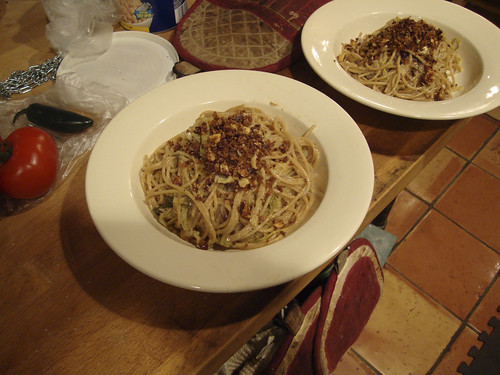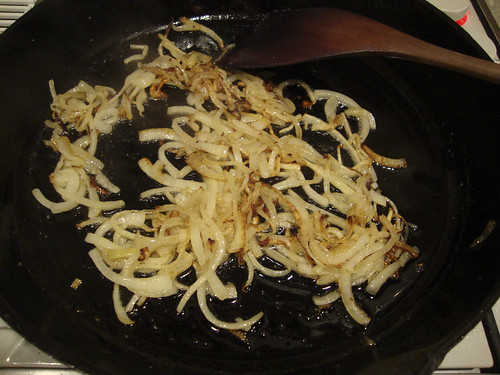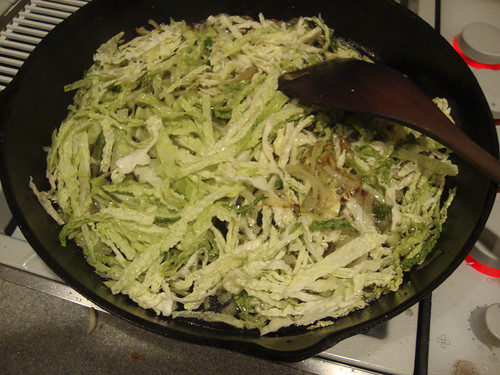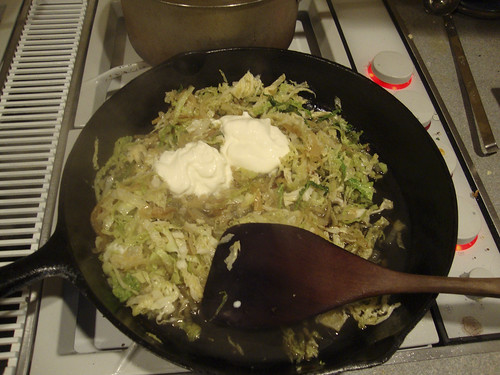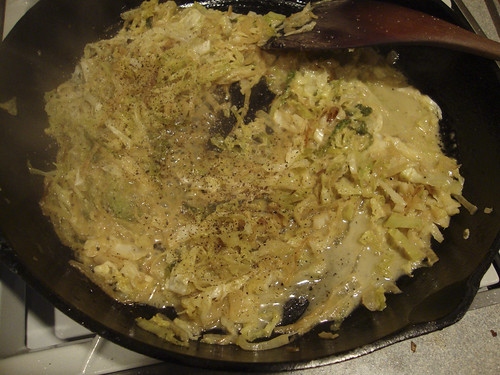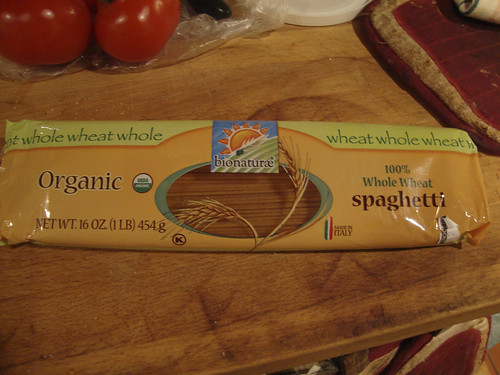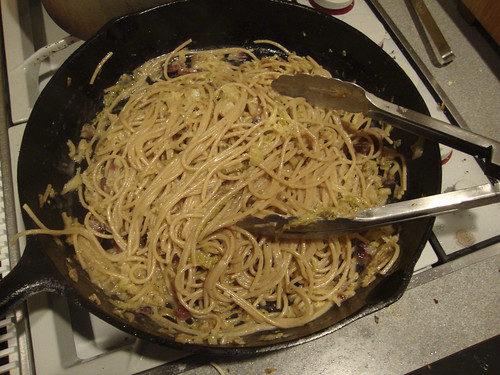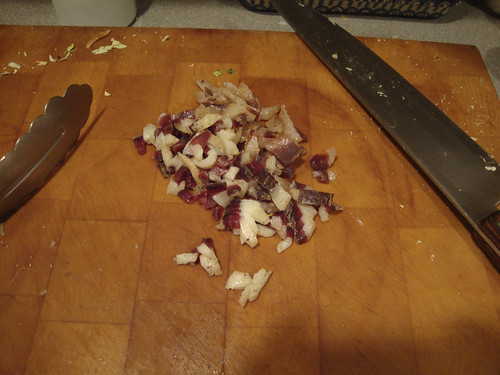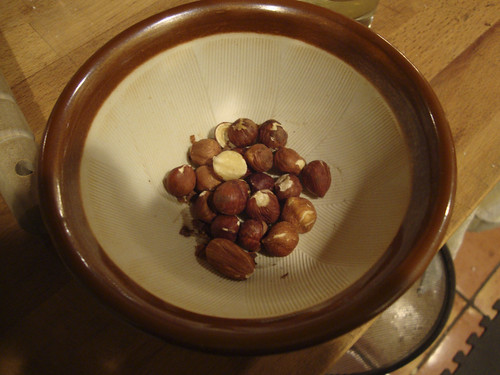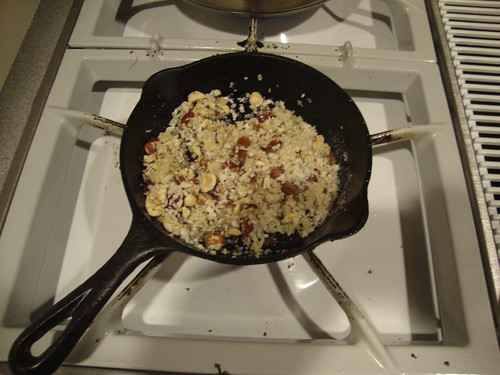
That said, when I heard that Dan Barber, the chef of Blue Hill and Blue Hill at Stone Barns, was going to host a "popup " series focused on this issue I was really intrigued. Then, when I realized that an already scheduled trip to NYC would coincide with the series, I was in.
The conceit of wastED is to challenge chefs and purveyors to find uses for food that is normally diverted from the "food stream." (My words, not his.) The extensive a la carte menu offered 21 dishes, all comprised of ingredients that would have either ended in landfill/compost, dog and cat food, or run down the drain. All dishes were priced at $15, which removed one decision-making variable.
I'd never dined at Blue Hill, but just walking in the door, I could tell that the restaurant had been transformed visually from its usual fine-dining look. My experience as a gardener told me that the walls and banquettes had been draped with Reemay, a row cover that I float over my garden to protect it from frost. It created an ethereal, cocoon-like effect. Knowing the intention of the event, I have no doubt that it will be reused back on a farmer's field later this spring.
The tables were set with resprouted vegetables--celery and bok choy plants had been regrown from their root ends (Cut a head of celery or choy about 3/4" from the bottom. Rest that root nub in water and a new plant will regrow. Pretty neat, yes? And very pretty.). Tables were laid with brown paper and set with a candle. The tabletops were made of mushroom growth medium (mycelium, think mushroomy styrofoam) and a fiberboard top made of some post-consumer product (I didn't get the actual product name, but will).
Onto the food and drink. I'm providing the menu descriptions as written by wastED.
I started with "The Boiler Maker: MacKenzie bourbon infused with walnut press cake (byproduct of nut oil production) infused bourbon, flat beer syrup, spent coffee grounds bitters." It was a nice take on a Manhattan, served up in a rocks glass so the aromas really concentrated. After my cocktail was gone, I moved to rosé (Matthiasson, Napa, 2014) for the rest of the meal.
Bread was presented at table: two hearty slices of spent grains bread (made from the grain left after beer brewing). The bread was served with two small dishes: one containing whipped lardo and cracklings, the other held salt, pepper and rosemary. The server picked up my candle and poured the melted wax over the salt and pepper. He turned the candle and I could see it was labeled "beef." It was tallow, and it my candle had become part of the bread course. This was probably the most "tricksy" thing I saw all night, and it delighted both me and the server, who told me he just loved that reveal moment. And it was delicious. The tallow got a little toasty from the candle flame. I'm a huge lardo partisan, but that beef fat won (and stopped) my heart.
"Stew of kale ribs: pockmarked potatoes and parsnips, shaved immature egg yolk." This was a creamy stew (it reminded me a lot of a soubise, the classic French onion-rice sauce). Beautifully cut batonets of potato and parsnip and thin kale stems. I'll confess that I wanted more kale, but it was nice to see something that I think of as a very fibrous ingredient become so tender. The immature egg yolk was a fun touch. When a laying hen is slaughtered, she will frequently have eggs "in process" internally. These yolks look just as you'd expect. They were cooked (I'm guessing cured, actually, though I forgot to ask.) and then the servers microplaned a small shower of the yolk over the stew.
"Monkfish wings: brine from the olive bin, trial fish pepper hot sauce." According to the extensive glossary provided on the menu, monkfish wings are the bones attached to monkfish fins (I had originally thought that what I was served was actually collar, but the menu tells me otherwise). Monkfish is a species that even a nose-to-tail chef like me almost never sees head-on. There is little market value in the head, so most fisherman toss the head and fins overboard to save space in the hold. The wings were deep fried and served with a little squeeze bottle of hot sauce. I worked with fish peppers a few years ago for a special event, and my fingers tingled with phantom pain (way back when, I didn't wear gloves and the capsaicin kept my fingertips humming for days after the event). There was a surprising amount of meat on the wings, and like the tail meat we are more familiar with, it was succulent, almost a bit springy.
"WastED special: April Bloomfield remains of fins and field: local mackerel and fluke trim, red wattle trotter and head, lacto-fermented pulp, pickled vegetable scraps." This dish was served in a shallow bowl, and a fish broth was poured around the contents at table. Elements included a pair of fish balls (no, not that kind of fish balls!) made from fluke and mackerel. They were a little bouncy, not in an unpleasant way, and they were a nice contrast to the crunchy fried mackerel tail that garnished the plate, the broth was very delicate and let the flavor of the garnishes, the fermented pulp and shreds of pork, show through.
"Rotation risotto: second-class grains and seeds, squash seed pulp, pickled peanuts, spent cheese rinds." I was so excited to see this dish on the menu. Chef Barber spoke at Edible Institute last year, and he described this dish as the starting point for his musings on "use it all." The "second-class" grains and seeds referred to are the grains that his farmers grow on their field as part of crop rotations. In order to build up soil fertility and variety of grains and legumes are grown and then tilled in. His farmers are now harvesting some of that food before he plants are returned to the soil, and these grains make up the base of the dish. To me, this is one of the most exciting dishes on this menu. It represents a way in which farmland can be used to produce food year-round, and provide positive inputs to the soil without the addition of supplemental fertilizers.
"Dog food: unfit potatoes and gravy." As the menu tells us, this dish was inspired by the dog food produced by Dickson's Farmstead Meats. They use their unsellable offal cuts to produce a sellable product, dog food. Barber fleshed out (pun unintended) this rich meatloaf-like dish with the meat from a seven year-old dairy cow (when dairy cows are "retired" from service, they frequently are sold for dog food, as they are not seen as fit for human consumption). The dish was garnished with a little snowdrift of potato rissole (appropriate because it was snowing all through dinner). This plate was delicious, but very very rich.
To cap off my meal, I concluded with "Double whey bread pudding: whey caramel, roasted reject apples, cacao pod husk whey sorbet." I opted for a option in which pork blood was substituted for the cream in the pudding custard. That option gave me a reverse supplement: I got 95 cents off for going "bloody." I really enjoyed this dessert. The sorbet had a very robust chocolate note from the husks (which gardeners would also recognize as the cocoa hull mulch you can by buy at garden centers). The pig blood gave dessert a rich, very savory note. I could imagine it being off-putting to some, but the apples brought enough acidity to counteract the "porkiness."
If you live locally, I strongly urge you to make the time to visit this event before it ends in a week. Some of the dishes do seem overly designed so as to use as much "waste" as possible, but the results were consistently excellent. The dinner series is reservation only before 9, with walk in tables available later in the evening.
This conversation should and will continue. I am very excited to see how we can bridge the gulf that lies between educating those of us who can afford a dinner like this one, and those who are actually going hungry. If wastED keeps us talking, and keeps us thinking creatively about diverting food from the waste stream, all the better.
I


